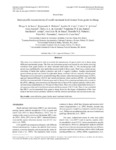Please use this identifier to cite or link to this item:
http://www.alice.cnptia.embrapa.br/alice/handle/doc/1035807| Title: | Interspecific transmission of small ruminant lentiviruses from goats to sheep. |
| Authors: | SOUZA, T. S. de  PINHEIRO, R. R.   COSTA, J. N.   LIMA, C. C. V. de   ANDRIOLI, A.   AZEVEDO, D. A. A. de   ARAÚJO, J. F.   SOUSA, A. L. M. de   PINHEIRO, D. N. S.   FERNANDES, F. M. C.   COSTA NETO, A. O.   |
| Affiliation: | Thiago S. de Souza, Universidade Federal do Recôncavo da Bahia - Cruz das Almas, BA, Brazil RAYMUNDO RIZALDO PINHEIRO, CNPC Joselito N. Costa, Universidade Federal do Recôncavo da Bahia - Cruz das Almas, BA, Brazil Carla C. V. de Lima, Universidade Federal da Bahia (UFBA) - Salvador, BA, Brazil ALICE ANDRIOLI, CNPC Dalva A. A. de Azevedo, Universidade Estadual Vale do Acaraú (UVA) - Sobral, CE, Brazil Juscilânia F. Araújo, UVA - Sobral, CE, Brazil Ana Lídia M. de Sousa, UVA - Sobral, CE, Brazil Danielle N. S. Pinheiro, Universidade Federal do Recôncavo da Bahia (UFRB) - Cruz das Almas, BA, Brazil Flora M. C. Fernandes, Universidade Federal da Bahia (UFBA) - Salvador, BA, Brazil Antonio O. Costa Neto, Universidade Estadual de Feira de Santana (UEFS) - Feira de Santana, BA, Brazil. |
| Date Issued: | 2015 |
| Citation: | Brazilian Journal of Microbiology, São Paulo, v. 46, n. 3, p. 867-874, July/Sept. 2015. |
| Description: | Abstrract: This study was conducted in order to evaluate the transmission of caprine lentivirus to sheep using different experimental groups. The first one (colostrum group) was formed by nine lambs receiving colostrum from goats positive for small ruminant lentiviruses (SRLV). The second group (milk group) was established by nine lambs that received milk of these goats. Third was a control group, consisting of lambs that suckled colostrum and milk of negative mothers. Another experimental group (contact group) was formed by eight adult sheep, confined with two naturally infected goats. The groups were monitored by immunoblotting (IB), enzyme-linked immunosorbent assay (ELISA), agar gel immunodiffusion (AGID) and nested polymerase chain reaction (nPCR). All lambs that suckled colostrum and milk of infected goats and six sheep of the contact group had positive results in the nPCR, although seroconversion was detected only in three of the exposed animals, with no clinical lentiviruses manifestation, in 720 days of observation. There was a close relationship between viral sequences obtained from infected animals and the prototype CAEV-Cork. Thus, it was concluded that SRLV can be transmitted from goats to sheep, however, the degree of adaptation of the virus strain to the host species probably interferes with the infection persistence and seroconversion rate. |
| Thesagro: | Ovino Cordeiro Caprino Doença animal Transmissão de doença |
| NAL Thesaurus: | Sheep Lambs Goats Lentivirus Disease transmission Visna maedi virus Cross infection |
| Keywords: | Maedi-Visna Artrite-encefalite Caprina Infecção cruzada CAEV LVPR SRLV Caprine arthritis encephalit virus |
| DOI: | http://dx.doi.org/10.1590/S1517-838246320140402 |
| Type of Material: | Artigo de periódico |
| Access: | openAccess |
| Appears in Collections: | Artigo em periódico indexado (CNPC)  |
Files in This Item:
| File | Description | Size | Format | |
|---|---|---|---|---|
| CNPC2015Interspeciestransmission.pdf | 740.94 kB | Adobe PDF |  View/Open |









